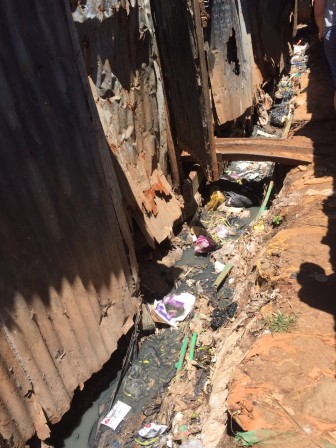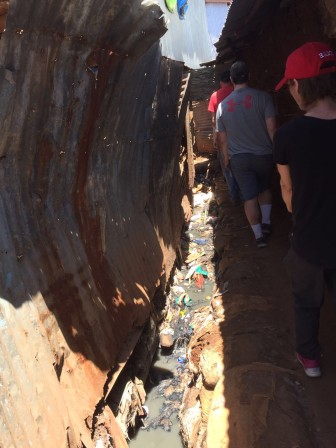On our first day in Kibera, Facing the Future, or “FAFU,” was likened to an oasis, and I’m not sure we fully comprehended the comparison until we had the opportunity to visit a couple of the students’ homes today.

The trench filled with waste in Kibera. Anne Goebel photo
The first day we arrived we had taken, what appeared to be the main roadway through Kibera, and walked a side path the rest of the way to FAFU. I truly thought that we had gotten a glimpse into what Kibera was like, but today I see how truly naïve that assumption was.
The slum is approximately the same size as Central Park, and the deeper you go into the mud and corrugated tin maze, the worse the living conditions become. There was a small trench that ran alongside the footpath, and it was filled with sewage and garbage. The general consensus from the group was that the stench was absolutely oppressive—a mixture of rotting food, human waste, and burning charcoal. It was suffocating at times.

Volunteers with the New Canaan Y navigated their way through the Kibera Slum. Anne Goebel photo
As we continued into the slum, our senses were on overload. We had to watch out for low-hanging roofs and archways, mind our step (so as not to slip off of the narrow path), and navigate the unevenness of the terrain. A few of us bumped our heads along the way, myself included. We weren’t sure where to focus our attention.
We arrived at one residence, which was the home of three FAFU students, their younger sibling, and two parents. We entered through an archway, and continued down a dark hallway until arriving at the one-room living space. The room was divided by a hanging sheet; on one side a couch and coffee table, on the other a bed. We weren’t permitted into the sleeping quarters, but we found out later the older children sleep in the main living area on the floor. The living quarters were tiny, and I think the idea of six people living there shocked our group.
Despite the small, dark residence there was one thing that was abundantly clear: The parents were extremely invested in their children’s education. They had enrolled their children at FAFU after hearing positive feedback from their neighbor about the school. The father also shared that his greatest concern was being able to afford the looming high school tuition for his children—something he doesn’t have to worry about while they attend FAFU.
Later in the day, we learned some staggering statistics regarding education in Kibera. Only 50 percent of children who live in the slum actually attend primary school, and of those children only 10 percent will move on to attend high school. The numbers provided were alarming, but reminded us again of FAFU’s importance within the community.
Yesterday was our first day visiting Kibera, but I think today we really saw Kibera.
[Editor’s Note: This week, we are publishing posts from Julia Douglas of the New Canaan YMCA as she writes from Nairobi, Kenya, where she’s volunteering with a team to build a playground in the world’s second largest slum, Kibera. Read all of Julia’s posts here.]

Anne Goebel, photojournalist! Go girl!